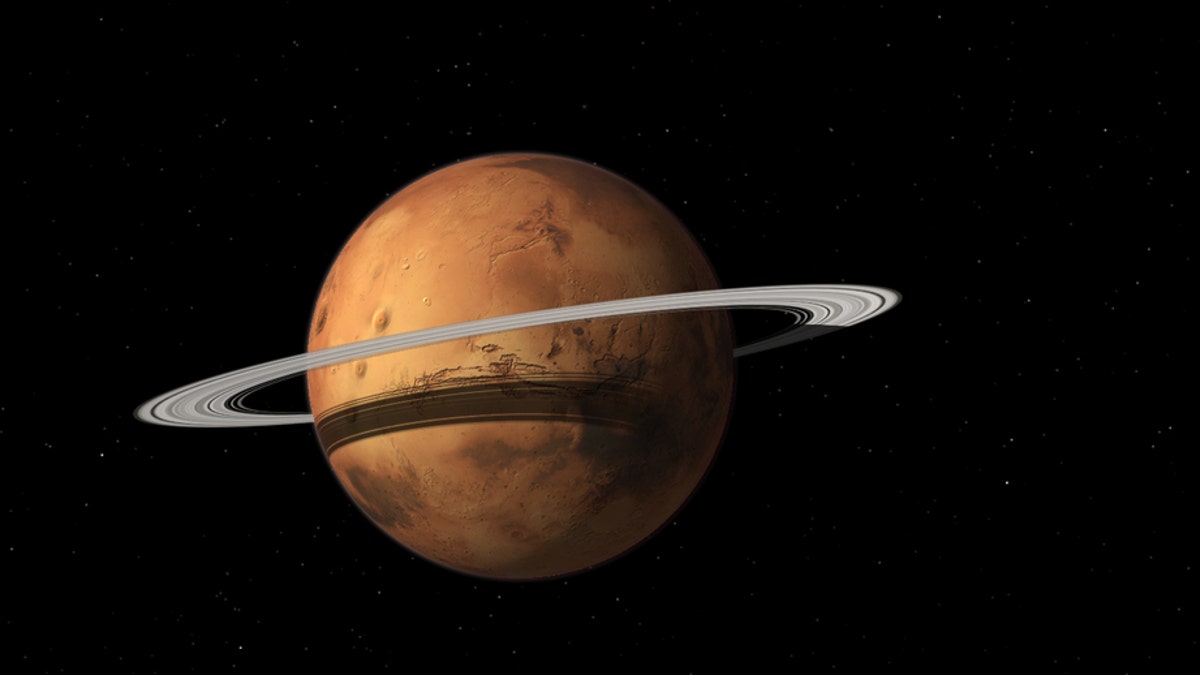
Re-add with new caption: Researchers think Mars' moon Phobos may someday reform into a ring around the rocky world. New work suggests that rocky planets with rings may be more common than previously thought, having been mistaken for another type of planet. (Made using Celestia, copyright (C) 2001-2010, Celestia Development Team)
Astronomers may have unknowingly discovered rocky planets with rings, which they mistook for other kinds of worlds, a new study finds.
Rings surround all this solar system's gas giant planets; they most famously wrap around Saturn, but also encircle Jupiter, Neptune and Uranus. In contrast, the solar system's rocky planets all currently lack rings.
However, rocky planets can have rings. For instance, Mars' moon Phobos might once have taken the form of rings around the Red Planet, the new study's author, Anthony Piro, an astrophysicist at the Observatories of the Carnegie Institution for Science in Pasadena, California, told Space.com. And as that moon gets closer to Mars over time, Phobos will likely get torn into a ring again "on a timescale of about 50 million years," Piro said. [Cosmic Speck: See Earth Through Saturn's Rings in Amazing Photo]
Astronomers could search for rings around rocky planets orbiting distant stars by looking for subtle effects that such rings would have as the planets passed in front of their stars from the viewpoint of Earth. Such rings could make these worlds look as if they are wider than they actually are, Piro said. That's why astronomers might have mistaken the ringed planets for another type of world.
More From Space.com
"Scientists have investigated the idea of rings around exoplanets that are like the giant planets in our solar system, but the idea of having rocky rings around more Earth-like planets has received less focus," Piro said.
Piro calculated how rocky exoplanets with rings might appear to astronomers as the worlds pass in front of stars. He found that rocky, ringed worlds might look like so-called sub-Neptune planets, a kind of world not seen in Earth's solar system. Sub-Neptunes are more than 1.6 times Earth's diameter but are smaller than Neptune, which is about 3.9 times Earth's diameter.
Most sub-Neptunes detected so far have low densities, which suggests they are not purely rocky, and scientists had suggested these planets had puffy, gaseous atmospheres rich in hydrogen and helium. However, Piro suggested that some worlds that looked like sub-Neptunes might actually be rocky planets with rings, and thus seem to have low densities because of the vast empty space between their surfaces and their rings.
Given rocky exoplanets each roughly the diameter and density of Earth, Piro calculated that rings with about 100 times the mass of Phobos or 5 percent the mass of Saturn's rings could last around such worlds for about 1 billion years or more. This means that astronomers could realistically detect ringed rocky planets, he said.
All in all, Piro estimated that ringed, Earth-size, rocky worlds might look like planets with diameters two or three times greater than Earth's. This is not unlike the sub-Neptunes astronomers have recently detected, he said.
Piro said he's not suggesting that all the worlds that scientists have currently identified as sub-Neptunes are actually rocky planets with rings. Rather, he suggested that the group of sub-Neptunes that astronomers have detected so far may be a good starting place for discovering ringed, rocky worlds.
One way to see if an exoplanet is a sub-Neptune or a rocky world with rings would involve looking at the light shining past the planet as the world passes in front of its star. "When light leaks through the atmosphere around an exoplanet, you can see some signs of what that atmosphere is made of," Piro said.
The spectrum of light from the exoplanet known as GJ 1214 b or Gliese 1214 b suggests that this world could have rings, Piro said. "But another explanation is that it's just really, really cloudy, which can happen if it has a lot of water," he said.
In another method to see if an exoplanet has rings, scientists could look for slight anomalies in the light as the planet starts and finishes passing in front of its star. "Scientists have done this for some larger exoplanets more like Jupiter in size but not so much for sub-Neptunes," Piro said.
Future generations of telescopes — such as the James Webb Space Telescope scheduled to launch in 2020 or the Giant Magellan Telescopeunder construction in Chile — may prove better at detecting rings around rocky exoplanets, Piro said. "Ringed, rocky exoplanets really feel like something from science fiction, like a 'Star Wars' type of planet," Piro said. "They seem like they'd be really cool places to live."
Piro detailed his findings online May 3 in a study submitted to The Astronomical Journal.
Original article on Space.com.
